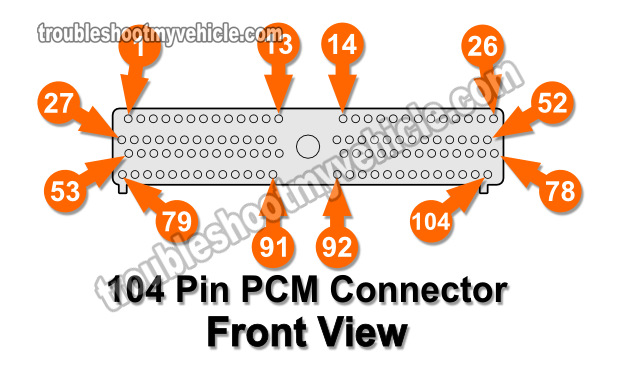TEST 2: Checking Continuity Of The TP Signal Circuit
The very first thing we'll do, is to check the circuit that feeds the throttle position sensor signal to your Ford's PCM.
The wire that feeds the throttle plate angle signal to the PCM is the GRY/WHT (gray w/ white stripe) wire of the throttle position sensor's connector.
The other end of the GRY/WHT wire connects to pin 89 of the PCM 104 pin connector.
IMPORTANT: Do not probe the front of the PCM 104 connector or you'll damage the terminal. This will require that you replace the entire engine wiring harness.
OK, these are the test steps:
- 1
Disconnect the battery negative cable and then unplug the PCM from its connector.
IMPORTANT: The battery negative cable will remain disconnected from the battery negative post for the remainder of the test. - 2
Connect the breakout box to the 104 pin PCM connector only. Do not connect the the Ford 104 pin breakout box to the PCM.
- 3
Place your multimeter in Ohms mode (Ω). We'll be checking the continuity of the circuit by checking its resistance.
- 4
Measure resistance between breakout box pin 89 and TPS connector terminal that connects to the GRY/WHT wire.
The GRY/WHT wire is the wire that connects to terminal 89 of the PCM 104 pin connector. - 5
Your multimeter should register 5 Ohms or less if the circuit is OK and has continuity.
Let's take a look at what your test results mean:
CASE 1: Your multimeter registered 5 Ohms or less. This test result tells you that the GRY/WHT wire is not ‘open’ between the TPS connector and the PCM 104 pin connector.
Your next step is to check the power circuit of the TPS. For this test go to: TEST 3: Checking Continuity Of The 5 V Reference Circuit.
CASE 2: Your multimeter DID NOT register 5 Ohms or less. If the resistance value is in the thousands of Ohms or your multimeter registered OL (over limit), then the wire is ‘open’.
This also means that the throttle plate signal that the TPS is creating IS NOT reaching the PCM.
Your next step is to repair the wire since, somewhere between the PCM connector and the TPS connector, this wire is broken. Repairng this ‘open’ in the GRY/WHT wire will get the TPS signal to reach the PCM and solve the TPS issue your Ford is currently experiencing.
TEST 3: Checking Continuity Of The 5 V Reference Circuit
Now that you've confirmed that the throttle position sensor's signal circuit does have continuity between the PCM's connector and the throttle position sensor's connector, the next step is to check the continuity of the circuit that feeds the TPS with power (5 Volts DC).
The wire that feeds the throttle position sensor with 5 Volts DC is the BRN/WHT (brown w/ white stripe) wire of the throttle position sensor's connector.
The other end of the BRN/WHT wire connects to pin 90 of the PCM 104 pin connector (these 5 Volts originate from the PCM).
IMPORTANT: Do not probe the front of the PCM 104 connector or you'll damage the terminal. This will require that you replace the entire engine wiring harness.
OK, these are the test steps:
- 1
Disconnect the battery negative cable and then unplug the PCM from its connector.
IMPORTANT: The battery negative cable will remain disconnected from the battery negative post for the remainder of the test. - 2
Connect the breakout box to the 104 pin PCM connector only. Do not connect the the Ford 104 pin breakout box to the PCM.
- 3
Place your multimeter in Ohms mode (Ω). We'll be checking the continuity of the circuit by checking its resistance.
- 4
Measure resistance between breakout box pin 90 and TPS connector terminal that connects to the BRN/WHT wire.
The BRN/WHT wire is the wire that connects to terminal 90 of the PCM 104 pin connector. - 5
Your multimeter should register 5 Ohms or less if the circuit is OK and has continuity.
Let's take a look at what your test results mean:
CASE 1: Your multimeter registered 5 Ohms or less. This test result tells you that the BRN/WHT wire is not ‘open’ between the TPS connector and the PCM 104 pin connector.
Your next step is to check the Ground circuit of the TPS. For this test go to: TEST 4: Checking Continuity Of The Ground Circuit.
CASE 2: Your multimeter DID NOT register 5 Ohms or less. If the resistance value is in the thousands of Ohm or your multimeter registered OL (over limit), then the wire is ‘open’.
Your next step is to repair the wire since, somewhere between the PCM connector and the TPS connector, this wire is broken.




